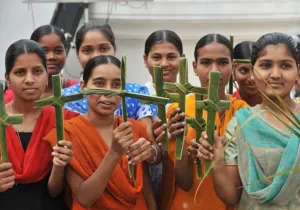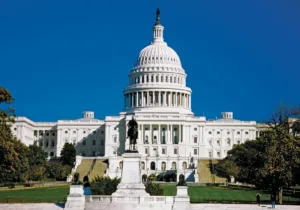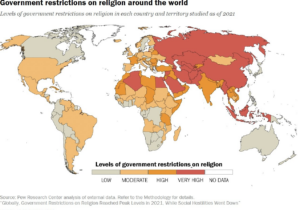Last weekend two bombings occurred during Palm Sunday services in two Coptic churches in Egypt. Here is what you should know about Coptic Christians, one of the world’s most persecuted religious groups.
1. The word Copt is derived from the Greek word for Egyptian. After the Muslim conquest of Egypt, it became restricted to those Egyptians adhering to Christianity. The term is typically used in reference to members of the Coptic Orthodox Church, though it is sometimes used to refer to any Christian groups in Egypt.
2. The majority of Copts belong to the Coptic Orthodox Church of Alexandria. About 800,000 others are divided between the Coptic Catholic and various Coptic Protestant churches.
3. Approximately 12 percent of the Egyptian population—roughly 11 million people—identify as Christian. Egypt’s Copts are considered the largest community of Christians in the Middle East, which makes them a frequent target of Islamic terrorist groups. Outside of the region, there are about one million members of the Coptic Orthodox Church, mostly in Australia, Europe, and North America. About 300,000 Copts live in the U.S., with the largest concentrations in New York, New Jersey, Boston, Chicago, Cleveland, Detroit, Houston, and Los Angeles.
4. According to tradition, the Coptic Orthodox Church was established circa AD 49 in Alexandria by St. Mark the Evangelist (the author of the Gospel of Mark), during the reign of the Roman emperor Claudius. In his fourth century book Ecclesiastical History, Eusebius writes, “And they say that this Mark was the first that was sent to Egypt, and that he proclaimed the Gospel which he had written, and first established churches in Alexandria.” (Ecclesiastical History 2.16)
5. The first ecumenical council, the First Council of Nicaea (325), was convened in part as a result of a theological dispute over the nature of Christ that was begun by Arius, an Alexandrian presbyter. And in the fourth ecumenical council, Council of Chalcedon (451), the Copts separated from the other churches—a split almost 600 years before the East/West Schism of AD 1054.
6. The Coptic Orthodox Church of Alexandria has its own pope. His official title is Pope of Alexandria and the Patriarch of All Africa on the Holy Apostolic Seat of Saint Mark the Evangelist of the Coptic Orthodox Church of Alexandria. (Not to be confused with the Greek Orthodox Church of Alexandria head bishop, who is alsoreferred to as the “Pope and Patriarch of Alexandria and All Africa” and whose full title is “His Most Divine Beatitude the Pope and Patriarch of the Great City of Alexandria, Libya, Pentapolis, Ethiopia, all the land of Egypt, and all Africa, Father of Fathers, Shepherd of Shepherds, Prelate of Prelates, thirteenth of the Apostles, and Judge of the Œcumene.”)
7. The Coptic language, used mainly in the church, is the last form of the ancient Egyptian language (originally written in picture-form called hieroglyphics). According to the World Council of Churches, the Coptic language is indispensable for the study of Pharaonic history and for biblical studies. In the second century AD, Pantaenus, the principal of the theological school in Alexandria, established the Coptic alphabet, using Greek characters and adding seven from the Egyptian which correspond to sounds that do not exist in Greek, in order to record phonetically the vernacular of Egypt.
8. Since their split with other Christian churches in the fourth century, the Coptic Orthodox Church has frequently been under persecution. When the Persians invaded Egypt in the sixth century, they destroyed most of the churches and monasteries. The Persians were later replaced by Arabs, who made Islam the dominant religion in Egypt. As historian Robert Morgan says, “Until the present day in the twenty-first century, the Christian Copts of Egypt are still suffering great injustice and undeclared persecution under the Muslim yoke inside Egypt.”
9. The terrorist group Islamic State (aka ISIS) targets Egyptian Christians simply because they are Christians in areas where the Islamic group has influence. Morning Star News reports that Islamic State released a video in February 2017 promising to rid Egypt of “idolaters.” The video features a recording of the suicide statement of a terrorist suspected in a December bombing of the Al Boutrosya Church who says that attack was “only the first.”
“There will be more operations in the near future, if God wills it, as you are our first target and our preferred target in our war,” he said. “You followers of the cross, you traitors of all ties—know that warriors of the Islamic State are watching you, and our blessed invasion won’t be our last on you. Because what’s coming is worse and hotter than boiling oil, so wait and see, we will be victorious.”
10. On Palm Sunday 2017, Islamic State took credit for two separate bombings of Coptic Orthodox Churches, which killed 47 and injured about 100 others. As The New York Times notes, “the attacks constituted one of the deadliest days of violence against Christians in Egypt in decades.”
The first attack at St. George’s Coptic Church in Tanta, a town north of the capital city of Cairo, killed 27 people and wounded 78 others. An explosive device had been planted under a seat in the main prayer hall. Most of those injured, according to an eyewitness, appeared to be priests and members of the choir.
A few hours later a suicide bomber blew himself up at St. Mark’s Coptic Orthodox Cathedral, the seat of the Coptic Church in Alexandria, where Coptic patriarch Pope Tawadros II led a Palm Sunday service inside. According to CNN, police officers posted outside the church stopped a man wearing an explosive belt from entering the church. At least two officers, a man and a woman, were killed, along with civilians and other police staff. In that attack, 16 people were killed and 41 others wounded. (It’s unclear where the other four deaths occurred.)
In response to the attacks, Egypt President Abdul Fattah al-Sisi has announced a three-month state of emergency.
—
Joe Carter is an adjunct professor of journalism at Patrick Henry College, an editor for several organizations, and the author of the NIV Lifehacks Bible.
Photo Credit: Inside a church in Al Fustat neighborhood, Cairo, Egypt. By Christopher Rose, via Flickr.






